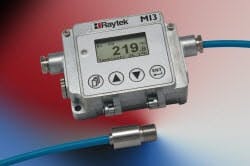Raytek, a leading worldwide provider of infrared (IR) thermometry, has introduced the MI3 Series of infrared temperature measurement sensors. The MI3 Series represents a new generation of performance and innovation in noncontact temperature monitoring for Original Equipment Manufacturer (OEM) applications and manufacturing processes.
The Raytek MI3 sensors deliver industry-leading performance and flexibility at the lowest installed cost per measurement point. Combining a rugged IP65 (NEMA 4) stainless steel sensing head with a separate communication module, the MI3 is designed to meet virtually any noncontact temperature measurement requirement.
According to Bill Kolbeck, Raytek Product Manager - Point Sensor Products, infrared thermometers, such as the MI3, are the fastest, safest and most cost-effective way to measure critical temperatures necessary for process control and automation. "Energy costs are typically one of the top three operating expenses in any manufacturing facility, and process heating is the largest portion of this expense," said Kolbeck. "The Raytek MI3 reduces energy costs by allowing tighter process control and more efficient process heating. Improved control performance usually results in less product variation, higher product quality and increased throughput."
Kolbeck indicated the new MI3 sensor provides all the functionality of the proven Raytek MI Series with significant new features. These include a broad choice of sensing head temperature ranges and spectral responses, a standard USB 2.0 digital interface for easy sensor set-up and configuration, a fully programmable electronics platform, and response times as fast as 20 mSec. The thermometer’s innovative multiple sensing head interface supports up to eight individually addressable heads per communication box.
The Raytek MI3 Series sensors offer a choice of scalable 0/4 to 20 mA and 0 to 5/10 VDC analog outputs, or Type J, K, R or S thermocouple outputs, as well as an optional RS485 network interface – thus, enabling seamless integration into existing control equipment or OEM systems.




